日内瓦希克里馆破壳而出
伊万·德勒蒙泰/Yvan Delemontey
朱琳 译/Translated by ZHU Lin
记忆和再生
栏目主持:阿尔伯托·博洛尼亚,米凯利·博尼诺,皮埃尔-阿兰·克罗赛特
有关20世纪建筑遗产和保护的问题经常与修复实践的问题联系起来——这类实践必须是一种保护的姿态和文化的行动,也必须是针对文化遗产修复的一种科学的介入。在现代建筑的保护实践中,对建筑作品价值的理解和对建筑在工业社会的艺术表达中所扮演角色的诠释是必不可少的;最终,这些作用机制(诸如建筑在当代社会价值体系中的接受、使用和传播等)具体到情景中,呈现出了争论中不应忽略的案例。
将希克里馆改造为文化中心的实践呈现了一种高度专业化的介入。它面向未来,旨在为后世还原出这座建筑在建筑与工程方面最初的重要成就,让人感受到当时带来的激动人心。2011年,该馆被作为历史遗迹纳入日内瓦州文化遗产目录,这一重要事件极大地改变了建筑本身的状态和意义1)。从功能和以生产为导向的使命来说,希克里馆是作为一座文化圣殿被选中的,它的建构表达理应被保留并铭刻到历史的记忆中。
如果将现代建筑的修复代入传统建筑修复的更广泛的讨论中,虽然它起源于后者,但也保留了一定的距离。在欧洲文化中,建筑修复是一种复杂的多学科的工作,其主要目标是确保历史遗迹得到保护,如此,在各种时间的痕迹当中,它才能作为历史遗存的记录传递到未来。一项建筑修复工程是复杂的历史性、批判性、科学性评估的结果,这一评估将建筑的精准的历史艺术信息与建构和工程分析结合起来。
意大利修复学科的先锋人物之一利利亚娜·格拉西写于1980年代初期有一个重要设想值得我们铭记。根据她的观点,她将修复实践定义为一种批判性的干预,“它的存在是基于对历史视角的认知,以及进一步的对现在与过去的差别的认知;所有的时代都处在自身的语境之中,任何一个都不能被特别地假定为一种范式。”[1]当更具体地谈到现代建筑的修复时,乔瓦尼·卡尔博纳拉按照年代区分并对比了对“新”的修复与对“老而古”的修复,并借之反思现代,其中也包括了最近的建筑事件[2]。
通过重建这一干预措施,希克里馆被视为这样一座现代建筑——它并不与过去相悖,与此同时,借助新的角色,它得以回到过去,作为连接未来的一座桥梁,并成为新的思考、实验与意义的载体。
(乔琪雅·赛斯塔洛)
Memory and Regeneration
Column Editors: Alberto Bologna, Michele Bonino, Pierre-Alain Croset
The questions related to the conservation and heritage of the twentieth Century architecture are often connected with the issue of the restoration practice that has to be intended both as conservative gestures and cultural acts, and as scientific interventions aimed to the restitution of the cultural heritage. The practice of the preservation of modern architecture cannot be excluded from the understanding of the architectural work's values and from the interpretation of the role of architecture as one of the industrial society artistic expression;finally, the contextualisation of these mechanisms,such as reception, use and transmission of the architecture within the contemporary society values,represent instances that cannot be omitted from the debate.
The conversion of the Pavillon Sicli into a cultural centre represents a high-specialised intervention that looks to the future and aims to give back to the next generations the pleasure of a primary importance asset from the architectural and engineering point of view. The acknowledgment of the pavilion as a monument and its inclusion, in 2011, among Canton of Geneva cultural heritage inventory marks an important event that drastically changes the status and the meaning of the building itself1). From a functional and production-oriented vocation, the Pavillon Sicli sees itself to be elected as a temple of culture, an architectonical expression to be preserved and handed over to the memory of the history.
The restoration of the modern architecture fits into the broader discussion of the traditional restoration from which it originates, but also keeps some relevant distances. In the European culture the architectural restoration is a complex and multidisciplinary project whose main purpose is to ensure the preservation of a monument in order to hand it over to the future as a document of the history maintaining, though, all the signs of the time.An architectural restoration project is the result of a complex historical, critical and scientific evaluation that combines an accurate historical and artistic knowledge of the artefact with specific architectonical and engineering analyses.
It is worth remembering an important assumption that one of the Italian pioneers of the Restoration discipline, Liliana Grassi, wrote in the early 1980s. According to her vision, she defines the practice of restoration as a critical intervention that "takes its raison d'être in the awareness of the historical perspective and therefore of the distinction, in continuity, of the present time from the past; distinction for which all epochs are placed in their situation without privileging one assuming it as a model"[1]. Speaking more specifically about restoration of the modern architecture Giovanni Carbonara chronologically distinguishes the restoration of the "New" in contrast to the restoration of the "Old and the Ancient" with a connotation of the modern that includes the most recent architectural events[2].
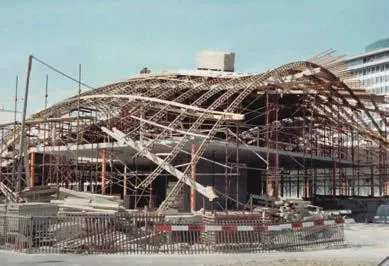
1 混凝土壳体的搭建框架/Building formwork for the concrete shell
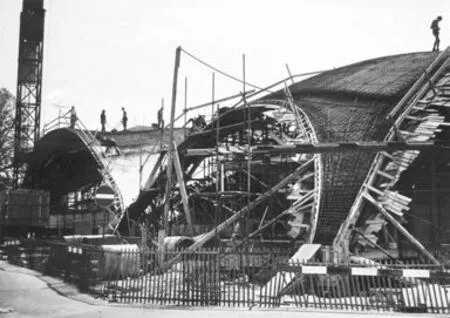
2金属支架与浇注的壳体/Metalwork and pouring of the shell
Through the intervention of regeneration,the Pavillon Sicli has been recognised as a modern architecture that is not opposed to the past meanwhile, thanks to this new vocation, it can be returned to the past acting as a bridge to the future and becoming bearer of new considerations,experimentations and meanings.
(Giorgia Cestaro)

3 拆除模板后的壳体/The shell after removal of the formwork(1-3图片来源/Sources: Archives SICLI Matériel incendie SA,Geneva)
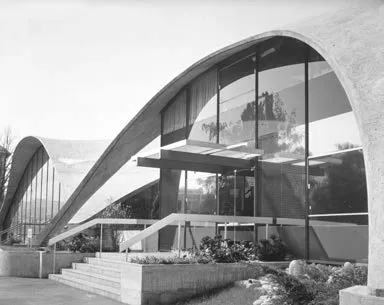
4 SICLI工厂入口,1970年代初/Entry to the SICLI Factory,early 1970s

5新 SICLI 工厂前的消防车,1970年代初/Fire-fighting vehicles in front of the new SICLI Factory, early 1970s(4.5 图片来源/Sources: Bibliothèque de Genève, Centre d'iconographie genevoise, fonds Piraud & Grivel)
日内瓦的希克里馆毫无疑问是瑞士近期工业建筑改造中最有趣的项目之一。建筑由灭火器制造商SICLI(全称为 Secours Immédiat Contre L'Incendie) 建造于1968-1970年,作为其瑞士总部,并由此得名。这座建筑既壮观又神秘。它包括两个体量巨大的长方体,交接在由7个支点支撑的不对称单体壳体之下。清晰的畅通无阻的内部空间形成了两个巨大的拱顶。稍大的一个顶部有透明的穹顶,是工厂的生产厂房。稍小的一个是两层的办公空间。异常轻薄的玻璃表皮围合了整座建筑,并延伸到自然采光的地下室,周围是一系列严整的花坛和树池。
这一出色作品由日内瓦建筑师康斯坦丁·希尔贝尔和工程师海因茨·伊斯勒共同完成。伊斯勒目前被看作是20世纪最重要的瑞士工程师之一,在瑞士和欧洲完成了数以千计的薄壳混凝土结构2)。在自然(贝壳、坚果、蛋壳、花瓣等)的启发下,他的设计推进过程几乎完全依靠实体模型来创造“自由的形式”,与通过数学公式(锥体、圆柱、椭圆、抛物面、双曲面等)得来的传统几何形式截然相反。其中一种方法被称作“悬挂翻转成膜法”:首先由几个点悬挂一片织物,然后涂上类似石膏或聚酯的雕塑材料,从而得到一种在重力作用下的纯受拉的悬挂形态。成型之后,这个形式被翻转过来,成为一个纯受压的壳体。
利用这一步骤并借助一系列模型,伊斯勒得到了希克里馆的极其复杂的壳体[3]。在场地施工中,它的建筑之美在技术和构造上得到了同样高水平的表现。建筑模板(由末端有胶合板曲梁的可调节管状元件和柔性的钢横梁以复杂的方式组装而成)一经完成,混凝土也已就绪,开始三天两夜不停歇地浇筑。这项操作非常棘手——壳体的厚度在底部的30cm到顶部的9cm之间连续变化,需要建筑工人有极好的技术。3周之后,壳体准备脱模,伊斯勒亲自到场监督——这一操作同样惊险,需要随时应对预应力钢索的拉力变化。这些钢索穿过楼板,将结构的7条非固定的“腿”一一连接起来。它们的作用是确保压力的稳定和一致,以保持结构的稳定性和风雨密性。
在作为工厂使用了40年之后,这座建筑被闲置。2011年,日内瓦州政府将其买下,希望改造成一座以建筑、城市规划与设计为主题的新的文化设施。第二年,遗产保护当局将其列入了州(文化遗产)名录。更名后的“希克里馆”在其所处的剧变中的工业区中占有重要位置,后者的选址非常优越,距离市中心很近。该馆处于一个完美的修缮状态,但是因为它现在需要容纳公众,遗产保护当局不得不进行残障和消防设施的升级工作。考虑到这座建筑的特殊意义,这些介入在进行伊始就设定为完全可逆的,并且对原始建筑的空间和结构产生的影响最小。
这些工作是a-architects建筑事务所的一个项目中的一部分。瑞士洛桑联邦理工学院的现代建筑技术和保护实验室被委派预先进行该建筑的遗产研究并提供咨询。这个项目旨在落实简单的高性价比方案,以替代经常对既有建筑产生消极影响的现行做法。
被列入名录意味着可以申请免除“能源升级”从而避免其带来的灾难性前景,但是为了最好地保留建筑的完整性和特质,立法上对消防安全的限制在项目初期就已经考虑在内。例如,建筑配有更多的紧急出口以在火灾时尽快地疏散人群,而不是围合原本设计中开放的空间和通道。另外,建筑师们通过大量的基本措施来修复原建筑年久失修的部分,包括复原了大拱顶的聚酯穹顶,修复了荒废多年的特色景观,甚至是拆除了窗户上的太阳膜,因其反射性和朦胧效果与当今设计师们追求的透明与无形格格不入3)。
希克里馆的新使命——在两个拱顶之下举办临时的低环境冲击的活动(展览、会议、临时展示等)——是值得赞许的。这些用途适合建筑的特质,并且避免了对建筑外部(立面和屋顶)和室内空间产生过大影响。最近,自然采光的开阔地下室空间也被重新激活,成为了日内瓦建筑与城市规划档案研究及文件中心。再一次,主持修复的建筑师们通过追求同样的低环境冲击和最小干预,精心地保留了成就其独特之处的工业特征。伴随着卡门·佩兰的雕塑作品《力量之线》在大拱顶的安装完成,希克里馆在2017年5月正式开放,现在,它正在经历一次成功的新生。开始时,人们并不确定结果会是怎样。但是,认可建筑的遗产价值,并选择适合既有空间的用途、谦逊和准确的建筑师团队和高效配合的利益相关者,还有也许是最根本的,对所面对的对象的特殊性达成共识——共同成就了这一具有普适性的方案。形态的改变是真实发生的,却几乎察觉不到——或许这正是这个值得赞扬的事业中最伟大的壮举。□

6 圆顶下的机械和装配工车间,1970年代初/Mechanics' and fitters' workshop, under the great dome, early 1970s (图片来源/Source: Bibliothèque de Genève, Centre d'iconographie genevoise, fonds Piraud & Grivel)

7入门门廊为紧急出口,该改建无需更动原立面/Entry porch serving as an emergency exit, added without modifying the original façade

8新增的用于装卸的可折叠楼梯/New collapsible stair for loading and unloading

9 北立面新增的二层应急楼梯/New emergency staircase at first floor level, north façade

10北立面新增的应急门/New emergency door, north façade.

11装修期间的地下室的档案和文件中心/Archives and documentation centre in the basement, during fitout(7-11摄影/Photos: Yvan Delemontey, 2019)
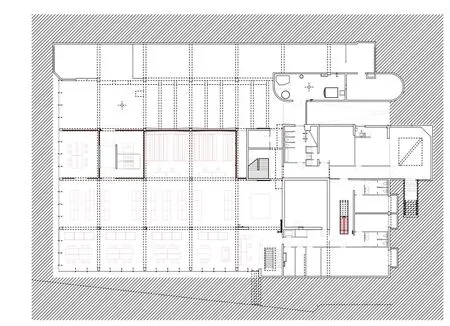
12目前的地下室平面(新加建部分为红色)/Plan of the basement in its present state (additions are shown in red)
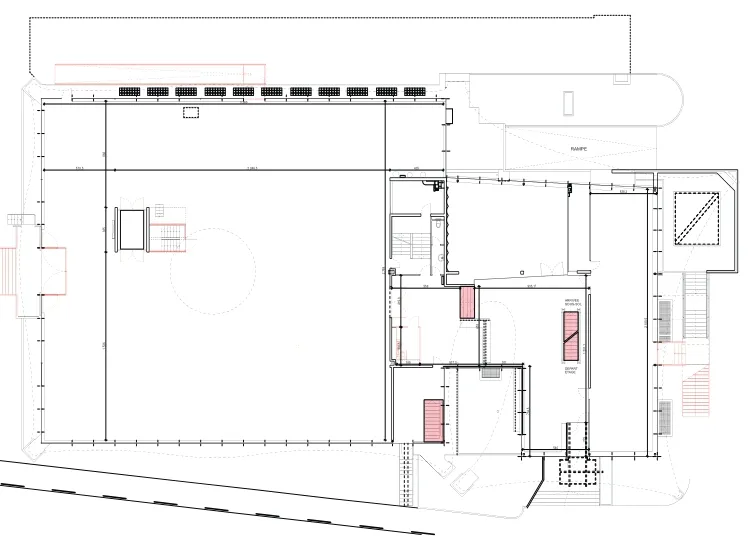
13目前的首层平面/Plan of the ground floor in its present state
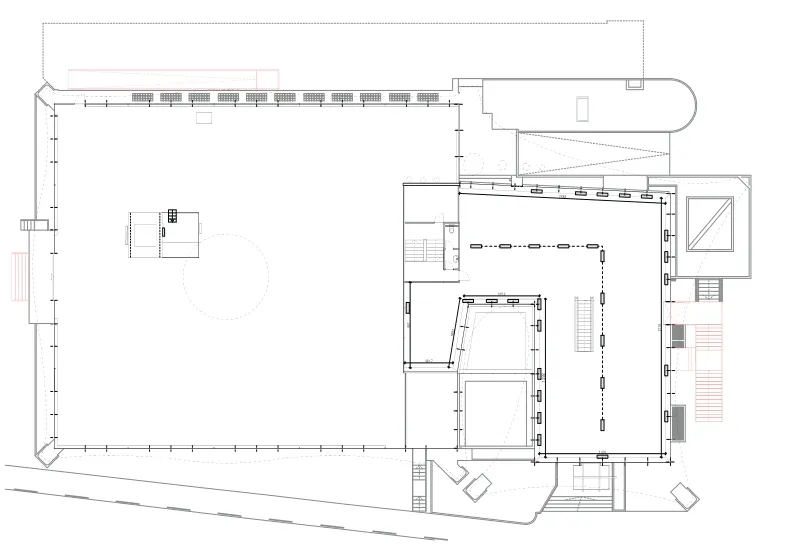
14目前的二层平面/Plan of the first floor in its present state
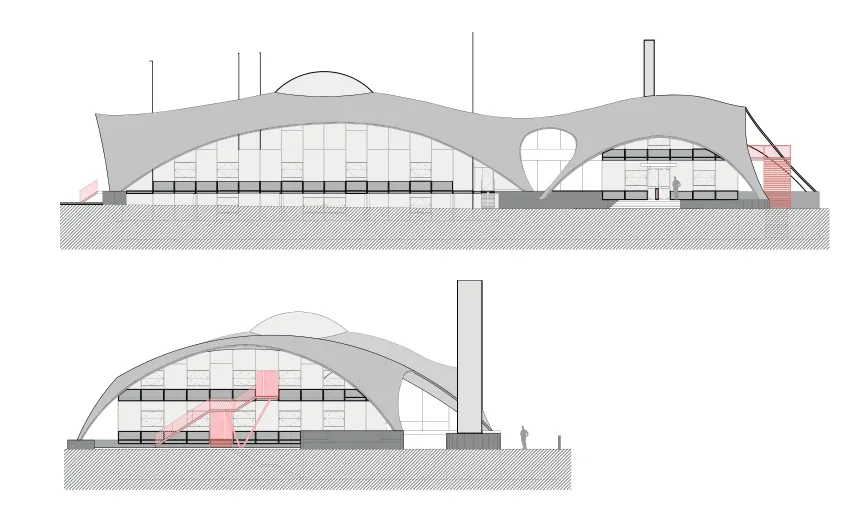
15目前的东立面与南立面/East and south façades in their present state

16目前的西立面与北立面/West and north façades in their present state.
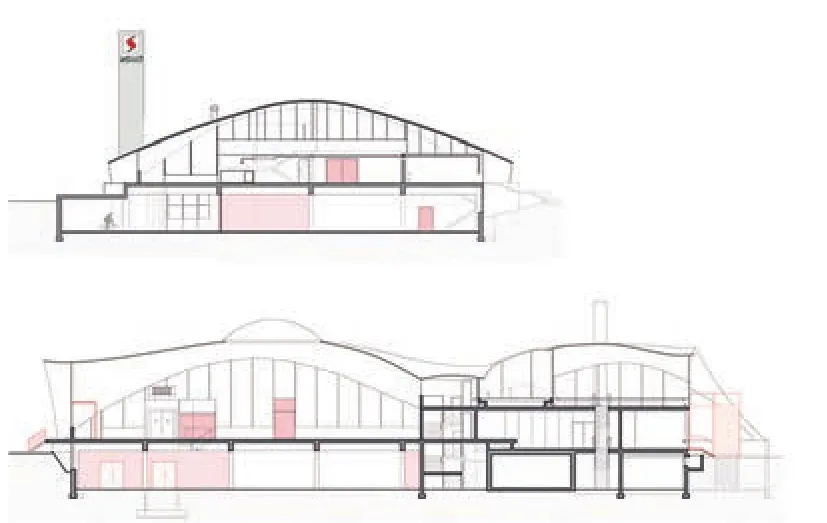
17横剖面与纵剖面/Transverse and longitudinal sections(12-17图片来源/Sources: a-architectes, Geneva)
The story of the Pavillon Sicli in Geneva is surely one of the most interesting of the recent rehabilitations of industrial buildings in Switzerland.Built by (and named after) the eponymous manufacturer of fire extinguishers (SICLI - Secours Immédiat Contre L'Incendie) between 1968 and 1970 as its Swiss headquarters, the building is both spectacular and enigmatic. It consists of two rectangular volumes of distinctive size joined beneath a single asymmetrical shell poised on seven feet. The clear, unobstructed interior space is defined as two vast domes. The larger is topped by a translucent cupola and was the factory's production plant.The smaller, arranged on two floors, contained the ffiices. The glazed skin that envelopes the whole is a remarkably light affair, extending down to the naturally lit basement, and encircled by a system of very restrained embankments and planters with trees.
It is the work of a talented design duo consisting of Geneva architect Constantin Hilberer and engineer Heinz Isler. Isler is now regarded as one of the principal Swiss engineers of the twentieth century, responsible for thousands of thin-shell concrete structures in Switzerland and across Europe2). Inspired by nature (seashells, nuts,eggshells, flower petals etc.), the design processes he developed are based almost solely on using physical models to create "free forms", as opposed to conventional geometric forms obtained by means of mathematical equations (cones, cylinders, ellipses,paraboloids, hyperboloids, etc.). One of these methods, known as "suspended inverted membrane",involves a piece of fabric suspended between several points, coated with a sculptural material such as plaster or polyester to obtain a hanging form in pure tension under gravity. Once the form is inverted,creating a shell in pure compression is created.
Using this procedure and by means of a series of maquettes Isler arrived at the particularly sophisticated shell form of the Geneva structure[3].In its execution on site, this piece of architectural brilliance achieves an equally supreme level of technical and constructional performance. Once the formwork is complete (a complicated assemblage of adjustable tubular elements with curved beams in glued laminated timber at the ends and flexible steel transoms) the concrete is ready for pouring,non-stop over three days and two nights. It is a tricky operation requiring immense skill on the part of the builder - the thickness of the shell varies continuously, from 30cm down to 9cm at the top.Three weeks later the shell is ready for striking,an equally perilous business coinciding with the tensioning of the pre-stressed cables, supervised in person on site by Isler. These cables pass through the ground floor slab and connect each of the seven mobile "legs" of the structure. Their role is to ensure the consistent and uniform compression needed to maintain stability and weather tightness in the structure.
Having served as a factory for 40 years, the building was decommissioned and then purchased in 2011 by the Canton of Geneva with an idea to transform it into a new cultural facility devoted to architecture, urban planning and design. The following year, the heritage authorities listed it,adding it to the Canton's inventory. Renamed"Pavillon Sicli", it has pride of place within an industrial area undergoing significant change,strategically located a short distance from the city centre. It is in an excellent state of repair, but since it is now required to accommodate the public the authorities have been compelled to undertake accessibility and fire safety upgrade works. Taking account of the building's exceptional significance,these interventions have from the outset been conceived to be fully reversible with minimum impact on the spaces and fabric of the original.
The works are part of a project developed by the architectural firm a-architects, in consultation with the Laboratory for the Techniques and Preservation of Modern Architecture (TSAM) at the École Polytechnique Fédérale de Lausanne (EPFL), which was tasked with preparing a heritage study of the building. The project aims to put in place simple,cost-effective alternatives to current practices which all too often have negative impacts for existing buildings.
Listing has meant that exemptions can be applied to avoid the disastrous prospect of an"energy upgrade", but legislative constraints for fire safety have been incorporated early in the program to best preserve the integrity and distinctive features of the architecture. For instance, it was decided to create more emergency exists to evacuate the public as quickly as possible in the event of a fire rather than to enclose spaces and paths of travel that were originally designed to be open. Moreover,a raft of basic measures have been taken to reinstate qualities proper to the building but lost over time,including restoring the polyester cupola in the great dome, reinstating landscape features that had been abandoned years before, and even the removal of solar films whose reflectivity and opacifying effects were at odds with the transparency and immateriality that the designers of the day were striving for3).
The Pavillon Sicli's new vocation - to host occasional, low impact activities under the two domes(exhibitions, conferences, temporary displays, etc) -is to be celebrated. These are uses that fit well with the nature of the building and avoid the need for heavy impacts to the envelope (façades and roof) and interior spaces. Most recently, the spaces inside the vast, naturally lit basement have also been reactivated as an archival research and documentation centre for architecture and urban planning in Geneva. Here again the architects leading the rehabilitation have taken care to conserve the industrial character that has shaped its identity by pursuing the same low impact, minimal approach. Officially opened in May 2017 with the installation of a sculptural work by Carmen Perrin (Lignes de forces) under the great dome, the Pavillon Sicli is enjoying a successful rejuvenation. At inception, there was no certainty of how things would turn out. But by recognising the building's heritage value, opting for a use compatible with existing spaces, humility and correctness on the part of the architects, productive collaboration among the stakeholders, and perhaps ultimately the common awareness of being in the presence of an exceptional object - a recipe for successful adaptation has been achieved. The metamorphosis is real but almost imperceptible. Perhaps that right there is the greatest feat of this commendable undertaking.□
注释/Notes
1)关于文化遗产在欧洲的概念,可参考以下文献/About European concept of Cultural Heritage,see: CHOAY F. L'allégorie du patrimoine. Paris, 1992.BABELON J P, CHASTEL A. La notion de Patrimoine.Paris, 1994.
2)关于伊斯勒和他的作品,可参考以下文献/On Isler and his work, see: BILLINGTON D P. Heinz Isler as Structural Artist. Princeton: Princeton University Art Museum, 1980. RAMM E, SCHUNCK E. Heinz Isler Schalen. Stuttgart: Karl Krämer, 1986. CHILTON J. The Engineer's Contribution to Contemporary Architecture -Heinz Isler. London: Thomas Telford Publishing, 2000.ABEL J, CHILTON J (ed.), Heinz Isler - 50 years of New Shapes for Shells, Journal of the International Association for Shell and Spatial Structures, Special Issue, 2011, 52(3).
3)这些太阳膜是建成之后不久加到窗户上的,为了减少室内工作人员的眩光,同时也是为了缓解长期以来困扰工厂的夏季室内过热的问题/These films had been applied to windows not long after completion to reduce glare for the staff inside. They also aimed to reduce overheating of spaces in the summer, which was a chronic problem at the factory.

